<- history index
<- Spin effects
-> HELIOS
Staff
Sverker Almehed, Guy von Dardel (R807), Göran Jarlskog, Bengt Lörstad
Students
Vincent Hedberg, Sten Henning (R807), Karin Kulka, Anders Melin (R807), Ulf Mjörnmark, Alf Nilsson (R807), Leif Svensson (R807), Göran Thorstensson, Torsten Åkesson
Detector
Cerenkov arm
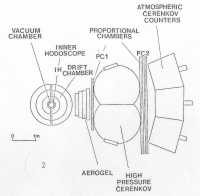
|
2pi calorimeter
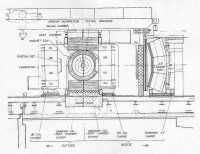
|
R808
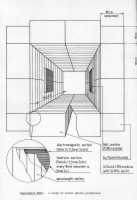
|
Abstract R807
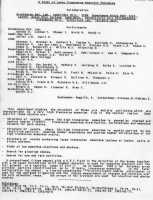
|
Abstract R808
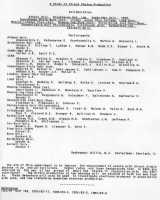
|
Photos
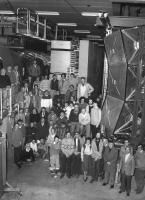 The collaboration gathered in the experimental hall 8 at ISR. Five persons from Lund can be found on the photo.
The collaboration gathered in the experimental hall 8 at ISR. Five persons from Lund can be found on the photo.
|
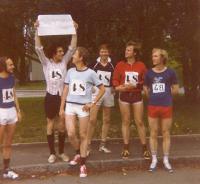 One of the yearly event at CERN is the CERN relay. The AFS group was participating in this event.
Half of the team in the year that the photo was taken was from Lund. AFS did win one trophy during
the active period, the one that was given to the team that finished exactly in the middle. One of the yearly event at CERN is the CERN relay. The AFS group was participating in this event.
Half of the team in the year that the photo was taken was from Lund. AFS did win one trophy during
the active period, the one that was given to the team that finished exactly in the middle.
|
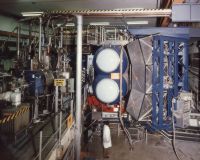 The Cerenkov arm consisted (from left) aerogel, proportional chamber,
high pressure cerenkov, proportional chamber, atmospheric pressure cerenkov.
The Cerenkov arm consisted (from left) aerogel, proportional chamber,
high pressure cerenkov, proportional chamber, atmospheric pressure cerenkov.
|
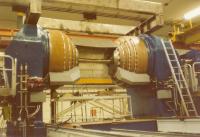 The magnet was an open axial field magnet, in order to avoid particles to traverse
magnet material. Around the beam pipe was a scintillator hodoscope, and around it the driftchamber.
The magnet was an open axial field magnet, in order to avoid particles to traverse
magnet material. Around the beam pipe was a scintillator hodoscope, and around it the driftchamber.
|
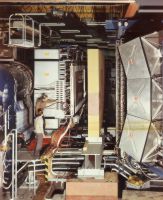 The Cerenkov arm was in a second phase replaced by a muon identification arm: the aerogel was replaced
with a uranium calorimeter wall (completing the 2pi calorimeter), and the high pressure cerenkov with
an iron shield that should absorb remaining non-muon particles.
The Cerenkov arm was in a second phase replaced by a muon identification arm: the aerogel was replaced
with a uranium calorimeter wall (completing the 2pi calorimeter), and the high pressure cerenkov with
an iron shield that should absorb remaining non-muon particles.
|
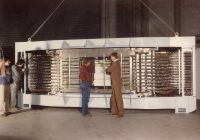 Aerogel cerenkov counter was designed and built by Lund. The aerogel material was manufactured in Lund.
On the photo is the aerogel inserted into the detector.
Aerogel cerenkov counter was designed and built by Lund. The aerogel material was manufactured in Lund.
On the photo is the aerogel inserted into the detector.
|
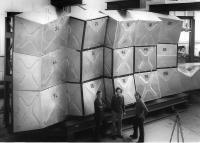 The atmospheric pressure cerenkov counter was designed and built by Rutherford.
It cosnisted of 21 modules. On the photo is the detector mounting almost complete.
The atmospheric pressure cerenkov counter was designed and built by Rutherford.
It cosnisted of 21 modules. On the photo is the detector mounting almost complete.
|
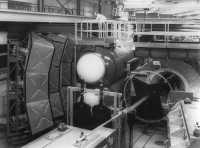 Side view of cerenkov arm. To the right is the magnet. The black things before the magnet,
along the beams, are scintillation counters. These were used for the luminosity measurement.
Side view of cerenkov arm. To the right is the magnet. The black things before the magnet,
along the beams, are scintillation counters. These were used for the luminosity measurement.
|
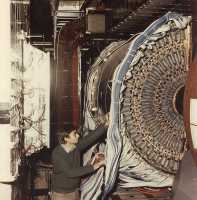 The drift chamber was made in two half cylinders. It had 42 sense wires radially distributed,
slightly staggered to resolve the left-right ambiguity. The position along the wires was measured
with charge division.
To the left is the uranium calorimeter, on it the sodium iodide detector.
The drift chamber was made in two half cylinders. It had 42 sense wires radially distributed,
slightly staggered to resolve the left-right ambiguity. The position along the wires was measured
with charge division.
To the left is the uranium calorimeter, on it the sodium iodide detector.
|
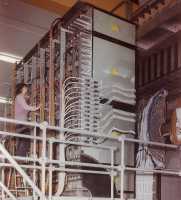 The calorimeter was an uranium sandwich calorimeter. The neutron induced fission in the uranium
improved the energy resolution. In the corners was the uranium replaced with copper. The readout was done
with photo multipliers.
The calorimeter was an uranium sandwich calorimeter. The neutron induced fission in the uranium
improved the energy resolution. In the corners was the uranium replaced with copper. The readout was done
with photo multipliers.
|
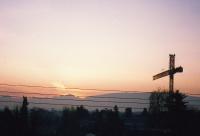 The experiment was located in intersection eight at the Intersecting Storage Rings. One advantage of this
was the view one had from the control room of the rising sun behind Mont Blanc.
The experiment was located in intersection eight at the Intersecting Storage Rings. One advantage of this
was the view one had from the control room of the rising sun behind Mont Blanc.
|
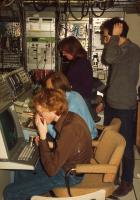 At the control desk. The main console was line mode terminal, and the tektronix was used for
graphical display. The readout was CAMAC based, controlled from a PDP 11/60.
At the control desk. The main console was line mode terminal, and the tektronix was used for
graphical display. The readout was CAMAC based, controlled from a PDP 11/60.
|
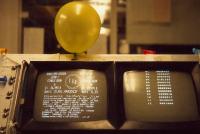 At the control desk, the ISR status. The photo shows status of the last fill 23/12 1983. ISR was
then closed down, to allow the building of LEP.
At the control desk, the ISR status. The photo shows status of the last fill 23/12 1983. ISR was
then closed down, to allow the building of LEP.
|
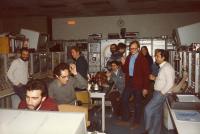 In the ISR control room the last fill. Though people look happy, good wine make always people happy,
was it a sad day for many.
In the ISR control room the last fill. Though people look happy, good wine make always people happy,
was it a sad day for many.
|
|
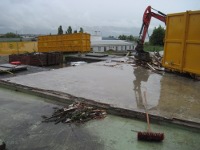 In spring 2013 the barack which housed the control room was dismantled to give place for a new experimental area.
View towards Mont Blanc.
In spring 2013 the barack which housed the control room was dismantled to give place for a new experimental area.
View towards Mont Blanc.
|
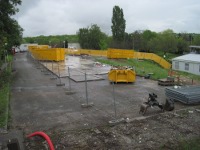 View towards Jura mountain.
View towards Jura mountain.
|
|




















